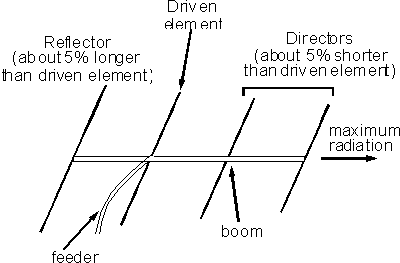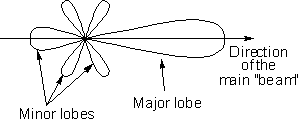The Yagi antenna
- overview, summary, tutorial about the Yagi antenna sometimes called the
Yagi-Uda RF antenna that is widely used where gain and directivity are required
from an RF antenna design.
The Yagi or Yagi-Uda RF antenna or aerial is one of the most
successful RF antenna designs for directive applications. It is used in a wide
variety of applications where an RF antenna design with gain and directivity is
required. It has become particularly popular for television reception, but it is
used in very many other applications where an RF antenna design is needed that
has gain.
The full name for the antenna is the Yagi-Uda antenna. It was
derives it name from its two Japanese inventors Yagi and his student Uda. The RF
antenna design concept was first outlined in a paper that Yagi himself presented
in 1928. Since then its use has grown rapidly to the stage where today a
television antenna is synonymous with an RF antenna having a central boom with
lots of elements attached.
The Yagi antenna
The Yagi RF antenna design has a dipole as the main radiating
or driven element. Further "parasitic" elements are added which are not directly
connected to the driven element. Instead they pick up power from the dipole and
re-radiate it such a manner that it affects the properties of the RF antenna as
a whole.

Basic concept of a Yagi antenna
The parasitic elements of the Yagi antenna operate by
re-radiating their signals in a slightly different phase to that of the driven
element. In this way the signal is reinforced in some directions and cancelled
out in others. It is found that the amplitude and phase of the current that is
induced in the parasitic elements is dependent upon their length and the spacing
between them and the dipole or driven element.
Using a parasitic element it is not possible to have complete
control over both the amplitude and phase of the currents in all the elements.
This means that it is not possible to obtain complete cancellation in one
direction. Nevertheless it is still possible to obtain a high degree of
reinforcement in one direction and have a high level of gain, and also have a
high degree of cancellation in another to provide a good front to back ratio.
To obtain the required phase shift an element can be made
either inductive or capacitive. If the parasitic element is made inductive it is
found that the induced currents are in such a phase that they reflect the power
away from the parasitic element. This causes the RF antenna to radiate more
power away from it. An element that does this is called a reflector. It can be
made inductive by tuning it below resonance. This can be done by physically
adding some inductance to the element in the form of a coil, or more commonly by
making it longer than the resonant length. Generally it is made about 5% longer
than the driven element.
If the parasitic element is made capacitive it will be found
that the induced currents are in such a phase that they direct the power
radiated by the whole antenna in the direction of the parasitic element. An
element which does this is called a director. It can be made capacitive tuning
it above resonance. This can be done by physically adding some capacitance to
the element in the form of a capacitor, or more commonly by making it about 5%
shorter than the driven element.
It is found that the addition of further directors increases
the directivity of the antenna, increasing the gain and reducing the beamwidth.
The addition of further reflectors makes no noticeable difference.
The antenna exhibits a directional pattern consisting of a
main forward lobe and a number of spurious side lobes. The main one of these is
the reverse lobe caused by radiation in the direction of the reflector. The
antenna can be optimised to either reduce this or produce the maximum level of
forward gain. Unfortunately the two do not coincide exactly and a compromise on
the performance has to be made depending upon the application.

Polar diagram of the Yagi antenna
Gain
The gain of a Yagi antenna is governed mainly by the number
of elements in the particular RF antenna. However the spacing between the
elements also has an effect. As the overall performance of the RF antenna has so
many inter-related variables, many early designs were not able to realise their
full performance. Today computer programmes are used to optimise RF antenna
designs before they are even manufactured and as a result the performance of
antennas has been improved.
Feed impedance
It is possible to vary the feed impedance of a Yagi antenna
over a wide range. Although the impedance of the dipole itself would be 73 ohms
in free space, this is altered considerably by the proximity of the parasitic
elements. The spacing, their length and a variety of other factors all affect
the feed impedance presented by the dipole to the feeder. In fact altering the
element spacing has a greater effect on the impedance than it does the gain, and
accordingly setting the required spacing can be used as one design technique to
fine tune the required feed impedance. Nevertheless the proximity of the
parasitic elements usually reduces the impedance below the 50 ohm level normally
required. It is found that for element spacing distances less than 0.2
wavelengths the impedance falls rapidly away.
To overcome this, a variety of techniques can be used. One is
to use a folded dipole for the driven element. This provides an increase in
impedance of around four times dependent upon the ratio of the thicknesses of
the basic dipole conductor and the "fold" conductor. Other techniques involve
using gamma matches, delta matches, baluns and the like. Delta matches can be
very convenient. They involve "fanning out" the connection to the driven
element. This method has the advantage that the driven element does not need to
be broken to apply the feed as shown. As this is really applicable to a balanced
feeder, a balun is required if coaxial cable is to be used.
A gamma match is another alternative that is often used. The
outer or braid of the coax feeder is connected directly to the centre of the
driven element. This can be done because the RF voltage at the centre is zero at
this point. The inner conductor of the feeder carrying the RF current is taken
out along the driven element. The inductance of the arm is then tuned out by the
variable capacitor. When adjusting the RF antenna design, both the variable
capacitor and the point at which the arm contacts the driven element are
adjusted. Once a value has been ascertained for the variable capacitor, its
value can be measured and a fixed component inserted if required.
Summary
The Yagi antenna is a particulary useful form of RF antenna
design. It is widely used in applications where an RF antenna design is required
to provide gain and directivity. In this way the optimum transmission and
reception conditions can be obtained.
|

